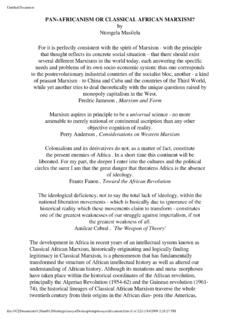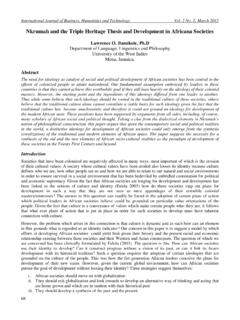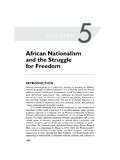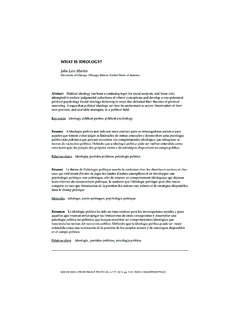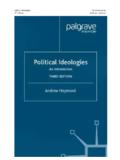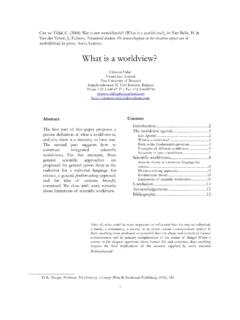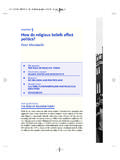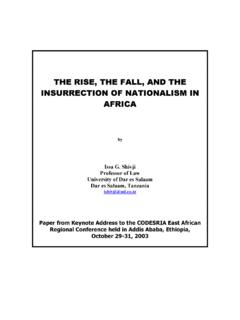Transcription of Africa’s Fear of Itself: the ideology of …
1 Africa s Fear of itself : the ideology ofMakwerekwerein south AfricaDAVID MARIO MATSINHEABSTRACTS ince the collapse of apartheid, the figure ofMakwerekwerehasbeen constructed and deployed in south Africa to render Africans from outsidethe borders orderable as the nation s bogeyman. Waves of violence againstMakwerekwerehave characterised south Africa since then, the largest of whichbroke out in May 2008 in the Johannesburg shantytown of Alexander. Itquickly spread throughout the country. The militants were black citizens whoexclusively targeted African foreign nationals, with some witnesses reportinggrotesque scenes of sadistic behaviour. So far these violent spurts have beendescribed as xenophobia, overlooking the history of colonial group relations inSouth Africa. From the perspective of this article, the history of colonial grouprelations cannot be overlooked, for the relations between citizens and non-citizens are extended shadows of this history.
2 I argue that, rather than rushingto characterise these relations as xenophobia, we should factor in the history ofcolonial group relations and the extent to which the post-apartheid ideology ofMakwerekwereand south Africa s we-image vis-a`-vis the rest of Africa maybear the imprints of this a century ago Fanon wrote of the black man as a phobogenic object, astimulus to anxiety among it is fair assessment to suggest thatAfricans are phobogenic unto themselves, that Africa is a stimulus to its ownanxiety. Africa s fear of itself is exemplified by the loathing of black foreignnationals in south Africa peculiarly by the nation s ex-victims of apart-heid which is increasingly becoming a fundamental component of SouthAfrica s collective identitification and public culture. Since the collapse ofapartheid, the phantom ofMakwerekwerehas been constructed and deployedin and through public discourse to render Africans from outside the bordersorderable as the nation s bogeyman.
3 Waves of violence againstMakwer-ekwerehave been rocking south Africa since 1994. The largest and bestknown broke out in May 2008 in a Johannesburg shantytown of quickly spread throughout the country. The militants were black citizenswho exclusively targeted African foreign nationals, with some witnessesreporting grotesque scenes of sadistic did victims ofDavid Mario Matsinhe is a policy analyst at Human Resources and Skills Development world Quarterly, Vol. 32, No. 2, 2011, pp 295 313 ISSN 0143-6597 print/ISSN 1360-2241 online/11/020295 19 2011 Southseries Inc., : become victimisers with such violent gushing of ire almostexclusively against Africans? This is the central concern of the to Danso and McDonald, south African xenophobia amountsto violent harassment of immigrants from other countries in Africa, killing tens, if not thousands.
4 3In a study of West African nationals inJohannesburg, a Nigerian national is quoted saying, it is hatred of blacksagainst blacks in which white foreigners are seen as tourists and blackforeigners as makwerekwere .4A joint statement by the Southern AfricanMigration Project (SAMP) and the south African Human Rights Commis-sion (SAHRC) indicates that the victimisation of black south Africans isbeing replaced by the victimisation of African foreigners, noting that notonly are more and more citizens becoming more xenophobic but they alsoperceive almost exclusively black foreigners as directly responsible forrising unemployment and violent 18 April 1997 aMail andGuardianarticle headlined Searching for a guilty Nigerian reportedactivities of the south African Narcotics Bureau policemen, describing howthey celebrated a colleague s birthday by endeavouring to arrest as manyNigerians as possible in the Hillbrow area.
5 6 Generally studies on SouthAfrican xenophobia agree that African foreign nationals are more likelythan other nationalities to be victims of physical study ofxenophobia on the University of Johannesburg campus made similarrevelations. A Turkish student notes that both black and white SouthAfricans equate the word foreigner with black foreigner , which in turn isgiven all different negative connotations . A Dutch student agrees, pointingout that not only do black south Africans loathe black nationalities butalso show a lot of respect to white people, because to them they are thecreators of wealth .8A recent study found that in south Africa s tourismindustry tourist is a whites only category; African foreign nationals arepersonae non and sourcesThis article is part of a larger study that involved 10 months of fieldwork,from October 2006 to August 2007, which comprised participant observa-tion, group and individualised interviews, informal conversations, and otherdata sources (see below).
6 The site of fieldwork was the inner city ofJohannesburg, particularly the neighbourhoods of Hillbrow and is an ideal location for a project of this kind for severalreasons. First, its mining industry has for generations attracted largenumbers of migrant workers from neighbouring countries, particularlyMozambique, Malawi and Lesotho. On the one hand, these migrants havecrystallised in different national groupings, forming a specific powerfiguration with each other. On the other hand, these various groupings areinterlocked in an established outsider figuration with the citizenry. Second,virtually all members of the established and outsider groups have no visibleskin colour or socioeconomic status differences. In many cases, they shareancestries, traditions and languages. This means that members of one group,DAVID MARIO MATSINHE296notably members of the establishment of the citizenry, engage in thenarcissism of minor differences to blame and stigmatise members of othergroups, particularly members of the weaker groups.
7 Third, since the early1990s Johannesburg has seen explosions of aggression and violence bymembers of the citizenry against members of outsider groups. The latestincidents of violence occurred in May 2008, killing over 60 (reported) foreignnationals, injuring over 600 and displacing over 30 is noteworthythat, although this latest spurt of violence was nationwide, Johannesburg wasthe centre-stage. As the media reported, the violence began from Johannes-burg and spread like wild fire across the , in this case elementsof the narcissism of minor differences animated the addition, there is a literature on attitudes towards foreign nationals inSouth Africa, out of which I draw on five sources: 1) reports on human rightsof foreign nationals produced by the Human Rights Watch (HRW) and theSAHRC; 2) official statements by politicians; 3) surveys on attitudes toimmigrants and immigration conducted underSAMP auspices; 4) theelectronic media and press articles; and 5) dissertations and other xenophobiaSeveral theses have been put forward to explain what is construed asxenophobia in south Africa.
8 Thus, for example, Morris proposes thescapegoat thesis, according to which the loathing of foreign nationals egblaming them for social ills such as crime, unemployment and the spread ofHIV/AIDS is the manifestation of frustration by poor and , Tshitereke s relative deprivation thesis contends thatdissatisfaction and frustration with the inadequacy and slowness ofredressing the inequalities of apartheid are leading the deprived masses toturn against foreigners: This is the ideal situation for a phenomenon likexenophobia to take root and flourish .13 Morris also proposes the isolation thesis, contending that the hostilitytowards foreign nationals issues from the prolonged seclusion of SouthAfricans, particularly blacks, which precluded contact not simply with theworld beyond Africa but with Africa demise of apartheid endedthe seclusion, opened the borders, and subjected citizens to overwhelmingexposure to the world .
9 Xenophobic sentiments and attitudes issue fromsudden and intense exposure to popular biocultural theory has been put forward, placing the unevenloathing of African foreign nationals squarely on their alleged visibleotherness: The biocultural hypothesis locates xenophobia at the level ofvisible difference, or otherness, ie in terms of physical biological factors andcultural differences exhibited by African foreigners in the country .15 Byclaiming that the Congolese and Nigerian nationals are easily identifiable asthe Other , Morris is also a proponent of this argument. Because of theirphysical features, their bearing, their clothing style and their inability tospeak one of the indigenous languages , he writes, they are in general clearlyTHE ideology OFMAKWEREKWEREIN south AFRICA297distinct and local residents are easily able to pick them out and scapegoatthem.
10 16 Harris suggests an explanation that situates xenophobia within theapartheid/post-apartheid transitional period, wherein broad social institu-tions such as the media produced negative representations of Africa andAfrican representations are congruent with the state scriminalisation of African foreign nationals as illegals , illegal aliens , illegalimmigrants , criminals and drug traffickers , most notably by the SouthAfrican Police Service and the Department of Home proposes an elaborate explanation that locates anti-Africanxenophobia within south African Poverty can only accountfor the powerlessness, frustration and desperation of the perpetrators, butnot for their target , he writes. Why [are] not Whites or the rich or for thatmatter White foreigners in south Africa targeted instead? .19He argues thatit is because of the anti-rural and pro-urban character of south Africannationalism, which during the apartheid era ruralised and devalued blacklives, on the one hand, whilst urbanising and valuing white lives, on theother.
